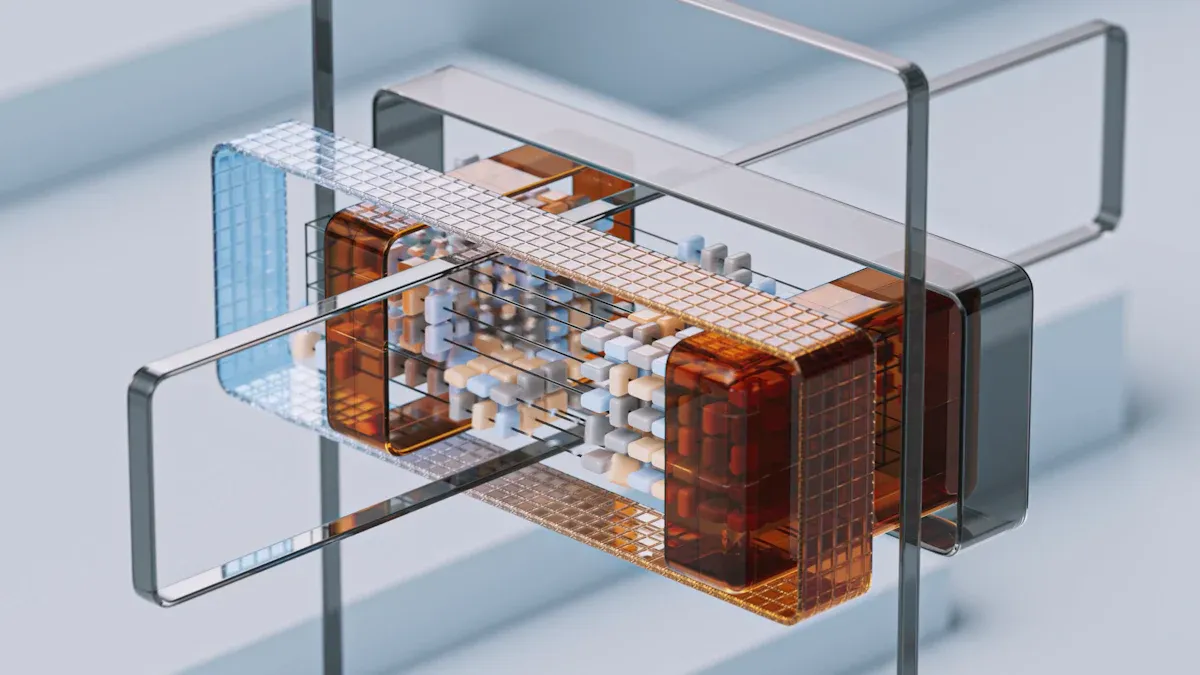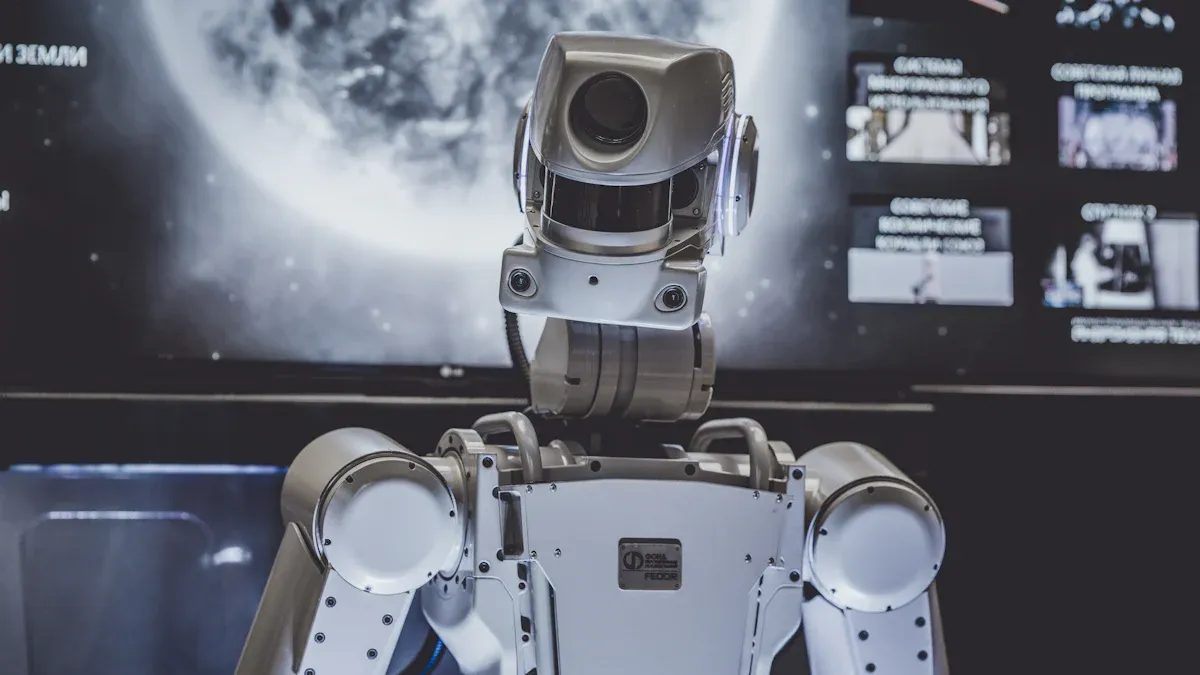Optimizing Machine Vision with Neural Architecture Search

You can revolutionize your approach to machine vision by leveraging Neural Architecture Search (NAS). This automated system eliminates the need for extensive manual effort in designing neural networks. For example, predictor-based methods in NAS swiftly estimate architecture accuracy, reducing evaluation time while maintaining precision. Additionally, NAS significantly boosts accuracy in machine vision systems, achieving up to 3.0% higher performance in hardware-optimized models. By automating architecture design, NAS enhances adaptability and efficiency, making it an indispensable tool in deep learning for diverse applications. Its transformative potential lies in optimizing neural architecture search machine vision systems for practical use.
Key Takeaways
- Neural Architecture Search (NAS) helps design neural networks automatically. It saves time and makes results more accurate. You can focus on solving problems instead of fixing designs by hand.
- NAS improves machine vision systems, boosting performance by up to 3.0%. It also lowers mistakes compared to older methods.
- NAS works well for many tasks, like sorting images or edge computing. It keeps models useful in different areas.
- Using NAS tools like EfficientNet creates smaller and faster models. These models still work great and are perfect for real-world use.
- Keep learning about new NAS ideas. They can make AI better and easier for more industries to use.
What is Neural Architecture Search (NAS)?
Definition and Purpose
Neural Architecture Search (NAS) is a method that automates the design of neural networks. Instead of manually crafting architectures, you can use NAS to explore and identify the best-performing models for your tasks. This approach saves time and reduces the complexity of building deep neural networks. It also ensures that the resulting models are optimized for accuracy and efficiency. By leveraging NAS, you can focus on solving problems rather than spending hours fine-tuning network structures.
Key Components: Search Space, Search Strategy, and Performance Estimation
To understand how NAS works, you need to know its three main components: search space, search strategy, and performance estimation. Each plays a critical role in finding the best neural network architecture.
| Component | Description |
|---|---|
| Search Space | Defines architecture components to be searched, including operations and connections. A well-designed search space can improve search cost and performance. Examples include sequential search spaces and cell-based search spaces. |
| Search Strategy | Explores the search space to discover optimal architectures with minimal samples. Various strategies have been developed, including weight-sharing mechanisms and predictor-based methods. |
| Performance Estimation | Estimates architecture performance, including expressiveness and generalization. Techniques include brute-force training, weight-sharing, and predictor-based methods to improve efficiency and accuracy. |
The search space acts as the foundation, outlining the possible configurations of your neural networks. A well-structured search space can significantly reduce the time and resources needed to find the best architecture. The search strategy determines how you navigate this space. For example, weight-sharing mechanisms allow you to evaluate multiple architectures simultaneously, saving time. Finally, performance estimation helps you predict how well a model will perform without fully training it. This step ensures that you can quickly identify the most promising architectures.
Role in Automating Neural Network Design
NAS transforms the way you design neural networks by automating the entire process. Traditionally, building deep neural networks required expert knowledge and extensive trial and error. With NAS, you can bypass these challenges. The system evaluates countless architectures and selects the best one for your specific needs. This automation not only speeds up the development process but also ensures that the resulting models are highly optimized.
For example, NAS has been instrumental in creating models for machine vision tasks like image classification and object detection. By automating the design process, it enables you to achieve higher accuracy and efficiency in your neural architecture search machine vision system. This adaptability makes NAS a powerful tool for a wide range of applications, from edge computing to resource-constrained environments.
Importance of NAS in Machine Vision
Automation of Complex Vision Tasks
You can simplify complex computer vision tasks by leveraging Neural Architecture Search (NAS). This automation eliminates the need for manual intervention, allowing you to focus on the broader goals of your project. NAS frameworks validate their effectiveness using performance metrics like accuracy and energy efficiency. For example:
- The Goodness Metric (GM) combines cost and model accuracy to evaluate NAS frameworks.
- Advanced models like EfficientNet and NASNet, developed using NAS, outperform manually designed architectures in benchmarks such as ImageNet.
By automating the design process, NAS enables you to tackle intricate tasks like image classification and object detection with greater ease. These models also optimize computational efficiency, ensuring that your neural architecture search machine vision system operates effectively in resource-constrained environments.
Tip: Automation through NAS not only saves time but also ensures consistent performance across diverse machine vision applications.
Enhancing Efficiency and Accuracy
NAS significantly improves the efficiency and accuracy of deep neural networks. When you use NAS, you benefit from frameworks that reduce error rates and optimize resource usage. Consider these comparative statistics:
- NAS achieves 2.86% less error compared to 10 randomly sampled architectures.
- It uses 31% fewer parameters on average, making models leaner and faster.
- Searching with operations yields an average accuracy of 89.92%, compared to 89.13% without operations.
These improvements highlight the transformative impact of NAS on computer vision tasks. For instance, the best model without operations achieves an accuracy of 95.82%, while the model with operations achieves 96%. This demonstrates how NAS frameworks refine neural networks to deliver superior results.
Note: Efficiency gains from NAS extend beyond accuracy. They also reduce computational costs, making it easier to deploy models in real-world scenarios.
Adaptability Across Diverse Applications
NAS adapts seamlessly to various machine vision applications, ensuring that your models remain effective across different domains. This adaptability is evident in frameworks like ISTS and AdaNet, which achieve competitive results compared to state-of-the-art NAS methods. Examples include:
- Breast Cancer Detection: Bioinspired NAS models analyze histopathology images with high precision.
- Image Classification: Adaptive structural learning in AdaNet optimizes network structures for diverse datasets.
- Spatial-Temporal Sequence Forecasting: ISTS adapts to pre-trained large language models, showcasing flexibility in handling complex data.
Additionally, NAS has been evaluated across ten carefully curated tasks, revealing inconsistencies in performance. This highlights the importance of robust evaluation methods to ensure adaptability in your neural architecture search machine vision system.
Insight: The ability of NAS to adapt across domains makes it a valuable tool for researchers and developers working on diverse machine vision challenges.
How Neural Architecture Search Works

Defining the Search Space
The search space is the foundation of neural architecture search. It defines the range of neural architectures that the process can explore. By setting clear boundaries, you ensure that the search remains efficient and focused. For example, a chain-structured search space organizes architectures as sequences of neural network layers. This structure simplifies the exploration process and makes it easier to identify high-performing neural network architectures.
When defining the search space, you can specify parameters such as the maximum number of layers, types of operations (e.g., convolutional layers or pooling), and associated hyperparameters. Cell-based search spaces, which focus on smaller, repeatable units, offer high transferability across tasks. However, they may not generalize well to all domains. To address this, researchers are exploring more flexible search spaces that adapt to diverse applications.
| Component | Description |
|---|---|
| Definition | The search space outlines potential neural architectures for discovery. |
| Example of Search Space | Chain-structured networks with sequences of layers. |
| Parameters | Includes layer count, operation types, and hyperparameters. |
| Generalization | Cell-based spaces transfer well but may lack broad applicability. |
| Research Direction | Flexible spaces for wider task adaptability. |
Applying Search Algorithms
Once the search space is defined, you apply search algorithms to navigate it. These algorithms help you discover the optimal neural network architecture by evaluating different configurations. Popular strategies include random search, reinforcement learning, and differentiable architecture search (DARTS). DARTS, for instance, uses gradient descent to streamline the process, making it faster and more efficient.
Search algorithms play a critical role in balancing exploration and exploitation. While exploration ensures that you consider diverse architectures, exploitation focuses on refining promising candidates. By combining these approaches, you can identify architectures that deliver both accuracy and efficiency.
| Key Aspect | Description |
|---|---|
| Differentiable Architecture | DARTS enables gradient-based search for faster results. |
| Search Strategies | Includes random search, reinforcement learning, and DARTS. |
| Evaluation Metrics | Accuracy, latency, and energy consumption guide the selection process. |
Evaluating and Selecting Optimal Architectures
After applying search algorithms, you evaluate the resulting architectures to select the optimal one. This step involves assessing metrics like accuracy, latency, and energy consumption. For example, a high-performing neural network architecture should deliver excellent accuracy while minimizing computational costs.
Evaluation methods vary based on the task. Some rely on full training to measure performance, while others use predictor-based techniques for faster results. Once you identify the optimal architecture, you can fine-tune it further to meet specific requirements. This ensures that your neural networks are not only efficient but also tailored to your application.
Tip: Focus on architectures that balance performance and resource efficiency for the best results.
Applications of Neural Architecture Search in Machine Vision

Image Classification and Object Detection
Neural Architecture Search has transformed how you approach image classification and object detection. By automating the design of neural networks, NAS enables you to achieve higher accuracy and efficiency in these tasks. For instance, NAS has been applied to face recognition tasks, where it outperformed leading methods like Adaface. The networks generated were up to two times smaller than commonly used ResNets, showcasing their efficiency.
NAS frameworks also allow you to optimize models for specific datasets, ensuring that the best model architecture is tailored to your needs. This adaptability makes NAS a powerful tool for image recognition tasks, where precision and resource efficiency are critical.
Insight: Smaller, optimized architectures not only improve performance but also reduce computational costs, making them ideal for real-world applications.
Edge Computing and Resource-Constrained Environments
In edge computing, where resources are limited, NAS plays a crucial role in creating efficient DNN architectures. By leveraging NAS, you can design models that balance accuracy and computational efficiency. Benchmarks like NAS-Bench-101, NAS-Bench-201, and NAS-Bench-301 highlight the performance of NAS in such environments:
| Benchmark | Search Space Size | Performance Metrics | Limitations |
|---|---|---|---|
| NAS-Bench-101 | ~423,000 | Accuracy, Training Time | Single-objective data only |
| NAS-Bench-201 | ~15,600 | Accuracy, Latency, FLOPs, Parameter Count, Training Time | Architectures are relatively small |
| NAS-Bench-301 | ~60,000 | Accuracy, Latency (predicted via surrogate model) | Focused on DARTS-based architectures |
The M-factor, which combines model accuracy and size, further demonstrates how NAS addresses efficiency limitations. Studies show that different NAS strategies yield varying M-factor values, helping you choose the most efficient approach for your neural architecture search machine vision system.
Case Study: EfficientNet and Its Role in Machine Vision
EfficientNet exemplifies the impact of NAS on advancing computer vision. This model achieves a top-1 accuracy of 84.4% and a top-5 accuracy of 97.1%, setting new standards for efficiency and accuracy. EfficientNet-B7, for example, is 8.4 times smaller than the best existing CNN while maintaining high performance.
This case study highlights how NAS enables you to design efficient DNN architectures that excel in both accuracy and resource usage. EfficientNet’s success demonstrates the potential of NAS to redefine what’s possible in machine vision, from image recognition tasks to real-time applications.
Tip: When selecting a NAS framework, focus on models like EfficientNet that balance size and performance for optimal results.
Challenges and Future Directions in NAS
Addressing Computational Costs
NAS often demands significant computational resources, which can limit its accessibility. You can overcome this challenge by adopting innovative methods like Efficient Neural Architecture Search (ENAS). ENAS automates the design of neural network architectures, reducing the computational burden.
- ENAS uses a parameter-sharing approach to minimize costs.
- It shares weights across different architectures, enabling efficient exploration of the search space.
- This method significantly reduces the resources required compared to traditional NAS techniques.
By leveraging such approaches, you can make NAS more practical for real-world applications, especially in resource-constrained environments.
Tip: Focus on frameworks like ENAS to optimize computational efficiency without sacrificing performance.
Designing Effective Search Spaces
The design of the search space plays a critical role in the success of NAS. A poorly defined search space can lead to suboptimal architectures and wasted resources. You can address this by creating structured and adaptable search spaces.
For example, chain-structured search spaces simplify exploration by organizing architectures as sequences of layers. Cell-based search spaces focus on smaller, repeatable units, offering high transferability across tasks. However, these may not generalize well to all domains. Flexible search spaces, which adapt dynamically to diverse applications, represent a promising direction for future research.
| Search Space Type | Advantages | Limitations |
|---|---|---|
| Chain-Structured | Simplifies exploration | Limited adaptability |
| Cell-Based | High transferability | May lack broad applicability |
| Flexible Spaces | Dynamic adaptation to tasks | Requires advanced design techniques |
By designing effective search spaces, you can ensure that NAS delivers optimal results across various machine vision applications.
Emerging Trends and Innovations in NAS
NAS continues to evolve, driven by emerging trends and innovations. You can benefit from these advancements by staying informed about the latest developments.
- NAS optimizes models for specific tasks, offering greater flexibility than traditional methods like LDA.
- Real-life applications, such as Google's AutoML, demonstrate the effectiveness of NAS in generating high-quality machine learning models.
- By 2025, NAS is projected to reduce the time required to develop new neural network models by up to 50%.
- Industry leaders predict that NAS will democratize AI development, making it accessible to more industries.
- Innovations like hybrid search algorithms and enhanced interpretability of architectures are expected to redefine NAS applications.
These trends highlight the transformative potential of NAS. By adopting cutting-edge techniques, you can stay ahead in the rapidly evolving field of machine vision.
Insight: Reinforcement learning-based nas frameworks are gaining traction as they combine exploration and exploitation to discover optimal architectures efficiently.
Neural Architecture Search (NAS) transforms how you approach machine vision. It automates neural network design, saving time and improving accuracy. You can rely on methods like PPCAtt-NAS to achieve superior performance compared to manual approaches.
- PPCAtt-NAS delivers higher architecture accuracy than state-of-the-art methods.
- It significantly reduces search time across diverse datasets.
- Its effectiveness ensures optimized models for real-world applications.
As computational challenges diminish, NAS will continue to drive innovation, making it a cornerstone of deep learning advancements.
FAQ
What is the main benefit of using Neural Architecture Search (NAS)?
NAS automates the design of neural networks, saving you time and effort. It identifies optimal architectures for your tasks, improving accuracy and efficiency. This makes it easier for you to focus on solving problems rather than manually fine-tuning models.
Can NAS work in resource-constrained environments?
Yes, NAS excels in resource-constrained settings like edge computing. It creates efficient models by balancing accuracy and computational costs. Frameworks like NAS-Bench-201 and EfficientNet demonstrate how NAS optimizes performance while minimizing resource usage.
How does NAS improve machine vision tasks like image classification?
NAS generates tailored architectures for specific datasets, enhancing accuracy and efficiency. For example, it has outperformed traditional methods in tasks like face recognition by creating smaller, faster, and more precise models.
Is NAS suitable for beginners in deep learning?
Absolutely! NAS simplifies neural network design, making it accessible even if you’re new to deep learning. Automated processes reduce the need for expert knowledge, allowing you to achieve high-quality results with minimal manual intervention.
What are the challenges of using NAS?
NAS can demand significant computational resources. However, methods like Efficient Neural Architecture Search (ENAS) address this by sharing parameters across architectures, reducing costs and making NAS more practical for real-world applications.
Tip: Start with lightweight NAS frameworks to explore its potential without overwhelming your resources.
See Also
The Impact of Neural Networks on Machine Vision Technology
The Role of Deep Learning in Improving Vision Systems
Will Neural Network Vision Systems Surpass Human Capabilities?
Understanding Computer Vision Models in Machine Vision Applications
Essential Libraries for Cutting-Edge Machine Vision Development
